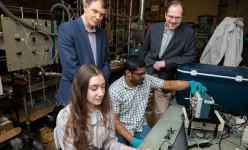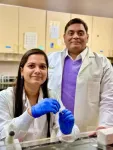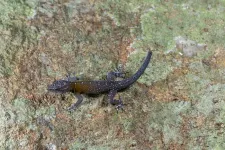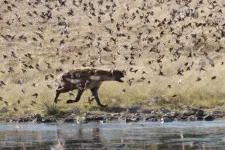(Press-News.org) A major global catastrophe could disrupt trade in liquid fuels used to sustain industrial agriculture, impacting the food supply of island nations like New Zealand that depend on oil imports.
A new study in the journal Risk Analysis suggests that New Zealand and other island nations dependent on imported fuel can plan for future emergencies by stepping up their production of biofuel from locally grown crops (like canola) and farming more fuel-efficient crops (like wheat and potatoes rather than dairy).
In the event of a major disruption in liquid fuel imports, results showed that New Zealand would run out of its stored diesel within weeks (with ordinary use) or months (with strict rationing). Investment in canola biodiesel or renewable diesel refineries could ensure a supply for the country’s bare minimum agricultural liquid fuel needs. In addition, fuel could be conserved by farming wheat or potatoes instead of more energy-intensive dairy.
###
About SRA
The Society for Risk Analysis is a multidisciplinary, interdisciplinary, scholarly, international society that provides an open forum for all those interested in risk analysis. SRA was established in 1980. Since 1982, it has continuously published Risk Analysis: An International Journal, the leading scholarly journal in the field. For more information, visit www.sra.org.
END
Biofuels could help island nations survive a global catastrophe, study suggests
2024-03-28
ELSE PRESS RELEASES FROM THIS DATE:
NJIT research team discovering how fluids behave in nanopores with NSF grant
2024-03-28
A research team from New Jersey Institute of Technology is uncovering mysteries surrounding fluids in nanoporous materials, and has been recently awarded a grant from the National Science Foundation (NSF) to support this research.
The research is focused on the elasticity, or compressibility, of fluids in these nanopores. Understanding the elastic properties of fluids has significant implications across multiple disciplines. Engineering applications, geological exploration, materials science and environmental studies ...
New study shows association of historical housing discrimination and shortfalls in colon cancer treatment
2024-03-28
BIRMINGHAM, Ala. – A nationwide study of 196 cities shows that housing discrimination from 90 years ago still casts a historical shadow of inequities in colon cancer care today, S.M. Qasim Hussaini, M.D., of the University of Alabama at Birmingham and colleagues at the American Cancer Society and Johns Hopkins School of Public Health report in the journal JCO Oncology Practice.
In the 1930s, the federally sponsored Home Owners’ Loan Corporation, or HOLC, used racial composition to map out residential areas worthy of receiving mortgage loans and those areas to avoid. Neighborhoods ...
Social media use may help to empower plastic surgery patients
2024-03-28
Waltham — March 28, 2024 — For patients considering or undergoing plastic and reconstructive surgery (PRS) procedures, using social media to gather information and answer questions can enhance patient empowerment – potentially leading to increased autonomy and better decision-making, reports a study in the April issue of Plastic and Reconstructive Surgery®, the official medical journal of the American Society of Plastic Surgeons (ASPS). The journal is published in the Lippincott portfolio by Wolters Kluwer.
"Our study suggests that connecting to social media is associated with meaningful increases in empowerment for PRS patients, ...
Q&A: How to train AI when you don't have enough data
2024-03-28
Artificial intelligence excels at sorting through information and detecting patterns or trends. But these machine learning algorithms need to be trained with large amounts of data first.
As researchers explore potential applications for AI, they have found scenarios where AI could be really useful — such as analyzing X-ray image data to look for evidence of rare conditions or detecting a rare fish species caught on a commercial fishing boat — but there's not enough data to accurately train the algorithms.
Jenq-Neng Hwang, University of Washington professor of electrical and computer and engineering, specializes in these issues. ...
Wayne State University researchers uncover potential treatment targets for Zika virus-related eye abnormalities
2024-03-28
DETROIT - A groundbreaking study published in the journal iScience presents crucial insights into the ocular effects of Zika virus infection during pregnancy and offers promising avenues for therapeutic intervention.
Produced by a team of researchers in the Department of Ophthalmology, Visual and Anatomical Sciences at the Wayne State University School of Medicine, the paper, “Targeting ABCG1 and SREBP-2 mediated cholesterol homeostasis ameliorates Zika virus-induced ocular pathology,” provides compelling evidence of the ...
Discovering Van Gogh in the wild: scientists unveil a new gecko species
2024-03-28
You’ve probably seen nature depicted in art, but how often do you see an artwork hiding in nature?
When they saw the back of a lizard in the Southern Western Ghats, a group of scientists from the Thackeray Wildlife Foundation in India were reminded of Van Gogh’s The Starry Night. As soon as they figured out it was a new species, it was only apt to name it in honour of the famous painter.
“Cnemaspis vangoghi is named for Dutch painter Vincent Van Gogh (1853–1890) as the striking colouration of the new species is reminiscent of one of his most iconic paintings, The ...
Small birds spice up the already diverse diet of spotted hyenas in Namibia
2024-03-28
Hyenas are generalist predators (and scavengers) with a broad range of prey species. They are known for hunting (or scavenging) larger mammals such as antelopes and occasionally feed on smaller mammals and reptiles. Being flexible in the choice of prey is a strategy of generalists – and this even extends to small passerine birds, as scientists from the Leibniz Institute for Zoo and Wildlife Research (Leibniz-IZW) and the University of Ljubljana observed in Namibia: Spotted hyenas pursued red-billed queleas, picked them from the ground or the surface of a waterhole and swallowed them whole, at a success rate of approximately one bird every three minutes. These observations were described ...
Imaging detects transient “hypoxic pockets” in the mouse brain
2024-03-28
Using a bioluminescent oxygen indicator, Felix Beinlich and colleagues discovered a spontaneous, spatially defined occurrence of “hypoxic pockets” in the mouse brain. Their technique offers a way to learn more about brain oxygen tension (pO2), a measure of oxygen delivery and demand in brain tissue that changes dynamically but is not well understood. The findings could have implications for how rest and exercise affect pO2 in the human brain, including the role of these activities in conditions such as dementia, Beinlich et al. suggest. The researchers used a genetically encoded bioluminescent oxygen indicator called Green NanoLuc in mouse cortical astrocytes to ...
Dissolved organic matter could be used to track and improve the health of freshwaters
2024-03-28
The dissolved organic matter (DOM) from hundreds of plant and animal remains could be used to track and possibly restore the health of freshwater bodies, Andrew J. Tanentzap and Jérémy A. Fonvielle write in this Perspective. The broad range of compounds, or chemodiversity, of DOM has multiple effects in freshwaters, including providing nutrients to support food web productivity, reducing or enhancing contamination from pollutants, and influencing the metabolism of microorganisms important to the biogeochemical cycle. DOM may also reduce the heat that ...
Indoor air quality standards in public buildings would boost health and economy, say international experts
2024-03-28
There should be mandatory indoor air quality standards, say an international group of experts led by Professor Lidia Morawska.
Professor Morawska, Vice-Chancellor Fellow at the University of Surrey and Distinguished Professor at Queensland University of Technology, led the appeal to the World Health Organization to recognise the airborne transmission of the virus which causes COVID-19 early in the pandemic – and help minimise it.
Now, in a paper published by the prestigious journal Science, Professor Morawska's international team recommends setting standards for ventilation rate and three key indoor pollutants: carbon ...




